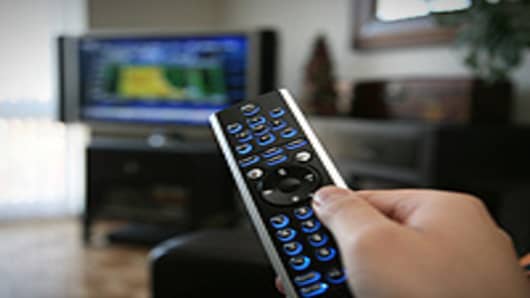Television used to be a fairly straightforward, one-way experience. Viewers sat on the couch, remote in hand, and passively flipped channels, hoping to find something interesting on the networks' schedules.
The rise of the DVR gave access to shows on the viewer’s timetable, and the explosion of apps like Netflix, Hulu and Amazon is putting control in consumers' hands — who can now watch anything, anytime, anywhere.
Speaking of control, a number of new TV sets — plus Microsoft's Xbox Kinect controller — make viewers the remote. One new Sonyremote has a touch-sensitive track pad on one side, and a Qwerty keyboard on the other. LG’s newest “magic remote” functions like a magic wand, allowing TV watchers to move a pointer on the screen. With Samsung, all they have to do is wave their hands to scroll through movie options. And Microsoft's Xbox system allows viewers to tell their television what to search for: "Xbox, search 'Harry Potter'," will bring them a list of different ways they can stream the various "Harry Potter" movies.
Now, TV will actually get viewers off the couch and onto their feet to interact with the TV and with the programming.
Microsoft gave us a behind-the-scenes tour of its research lab, and a demonstration of how to use the voice and motion control technologies of its Xbox controller to make TV programming interactive. Though we assumed "interactive television" would be just like a video game, it's actually a whole new category of entertainment.
One of the oldest names in children's programming is getting a makeover in collaboration with Microsoft, for what they're calling "Kinect Sesame Street TV." At various points in a "Sesame Street" show, characters such as Elmo ask viewers to participate — counting, throwing imaginary objects, or jumping. The camera, attached to the Xbox console, allows viewers' movements to impact what's happening on the TV. If kids don't want to jump for Cookie Monster, the technology can tell that they're not moving, so Cookie Monster encourages them to move. Once the activity is done, or if a kid decides to sit it out, Sesame Street continues to another part of the program.
Another program, Kinect NatGeo TV, makes wildlife documentaries fully immersive. For instance, a documentary about owls shows how they catch bugs, then asks viewers to stand up and try to catch bugs on the screen themselves. The camera captures the viewer's image and adds an owl face and wings to their body. When the viewer flaps his arms, it looks like he's an owl about to take flight. Then, when crickets fly near the viewer-turned-owl's face, he has to move and dive to catch them in his virtual mouth.
This technology that integrates a viewer's body into a TV show has seemingly limitless potential. We'll see what happens once reality TV producers get their hands on it.




